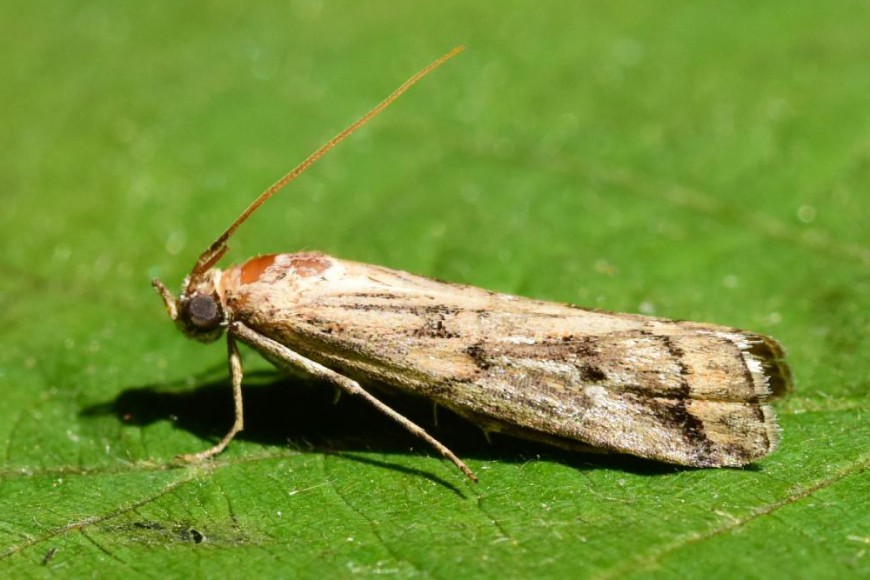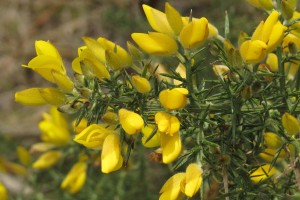Gorse colonial hard shoot moth
History in New Zealand
The gorse colonial hard shoot moth is native to western Europe and was first imported from Portugal by Manaaki Whenua - Landcare Research in 1995. The moth was not released in the field until 3 years later as it proved difficult to mass-rear indoors. An additional shipment was imported in 1999 to boost rearing stocks, allowing more widespread but still limited releases to be made. The moth has only established in the South Island and is quite commonly found in parts of Canterbury. We are unsure why it did not establish in the North Island – further efforts to establish the moth there could be made in the future. The moth has also been released as a biological control agent in Hawai’i but has not established there.
How would I find/recognise it and what is its lifecycle?
You are unlikely to see the moths as they are nocturnal and inactive during the day. However, if you look closely you may see the moths sitting upside down on or close to old larval webs around December/January. The moths are light brown in colour with darker black, brown and white markings on the wings and are about 10–15 mm long. The males have a small tuft at the base of the antennae, which gives rise to its common name in the UK, the gorse knot-horn moth.
The females lay their tiny bright red eggs during the summer months. They prefer to lay them inside old webs, but you may also see the eggs on maturing green foliage. The eggs develop slowly for 1–2 months before the caterpillars hatch out. Several caterpillars aggregate to spin a coarse creamy-grey web with many tunnels, often at the base of current growth. The caterpillars use this communal web as a base from which to forage on surrounding foliage in the autumn before hiding away inside the web during the winter.
In the spring the caterpillars become active again and enlarge the web to incorporate young buds, shoots, and flowers. The best time to see the communal webs is in November and early December when they are at their largest (up to 20 cm across with usually 2–9 caterpillars inside, but sometimes as many as 30) and feeding damage is also the most obvious. The webbing has what looks like tubes in it and distinctive balls of sawdust which is the frass from feeding larvae. If you look closely you may be able to see the green- and brown-striped caterpillars inside – they wriggle rapidly when disturbed.
The caterpillars feed and grow throughout the spring, reaching about 2.5 cm long before they finally pupate. You may see the dark reddish-brown pupae tucked away in the web. After about 2–3 weeks new adults emerge and begin to lay eggs. There is only one generation per year.
The gorse colonial hard shoot moth is easy to differentiate from most other gorse biocontrol agents. Gorse soft shoot moth caterpillars are the most likely to be mistaken for them but are solitary.
See Gorse pod moth, Gorse seed weevil, Gorse soft shoot moth, Gorse spider mite, Gorse thrips.
How does it damage gorse?
The caterpillars are the damaging stage, and they feed on the spines, leaves, buds, shoots and flowers. This feeding causes the foliage around the web to brown off and die. When the caterpillars are small, the area damaged around the web is only a few centimetres in diameter; but when the caterpillars grow large in the spring, the area damaged becomes much larger, commonly 20–40 cm around the web.
Will it attack other plants?
No, it is extremely unlikely that gorse colonial hard shoot moths will attack any plants other than gorse. Overseas it also attacks Ulex minor, which we do not have in New Zealand.
How effective is it?
No studies of the impact of gorse colonial hard shoot moth have been undertaken in New Zealand. Where outbreaks have occurred the damage to gorse has been noticeable, but the overall effect on plant growth is unknown.
How can I get the most out of it?
The moth is steadily extending its range but if not present in an area it could be collected and released there.
How do I select a release site?
Read Guidelines for selecting release sites for biocontrol agents.
How do I collect it for release at other sites?
Harvest branches with webs on them or whole bushes in early summer when large caterpillars or pupae are present. Shift at least several hundred webs to each new site. Wedge the infested material firmly into gorse bushes.
How do I manage the release sites?
Avoid any activities that will interfere with the moths, such as herbicide application. If you need to undertake control measures avoid the release site.
Key contact



